Notebook Trio: ASUS A8JS and G2P and ABS Mayhem Z5
by Jarred Walton on December 29, 2006 12:15 PM EST- Posted in
- Laptops
ASUS G2P - Exterior and Features
We received the ASUS A8JS first, and after our initial experience with it (and experiences with previous ASUS laptops), we had high expectations for the ASUS G2P. The G2P is part of ASUS' gaming laptop series - or their Personal Entertainment Center group - but having looked at the features and specifications of the other laptops in this line (the G1, G2P, G2Pb, and G2Pc) we would have to say that most of these do not really fit the requirements of a "gaming" notebook. They all feature Core 2 Duo processors and a reasonable selection of midrange components.
The problem is, as mentioned previously, that they all come with underpowered graphics chips. Well, perhaps not all - the G1 comes with a GeForce Go 7700, just like the A8JS, although it also comes with a 15.4" LCD with either a 1280x800 or a 1680x1050 native resolution. All of the G2P models on the other hand come with a 17" 1440x900 LCD and a Radeon Mobility X1700 graphics chip. Looking at the specs, the Mobility X1700 probably looks pretty similar to the Go 7700, but in practice it is significantly slower.
We're getting ahead of ourselves though, so let's talk a little bit about the laptop itself. Current prices on the G2P are around $1900, which is a bit more than the A8JS. You do get a larger 160GB hard drive, however, as well as 2GB of RAM standard on all G2P models. The price isn't an excellent bargain, but it isn't that bad either. Similar configurations from other manufacturers end up costing roughly $1800-$2000 as well, although the ability to customize your component selections might make the alternatives more attractive overall. The HP dv9000t for example offers very similar features (when upgraded) for about the same price.
Upon booting up the laptop you are greeted with a red and white logo accompanied by a gong noise and a subtitle proclaiming "ASUS Gaming Series". (The BIOS does allow you the option to disable the startup noise.) The exterior also gives the impression that this might actually be a gaming centric notebook, with red highlights in various locations, a glowing logo beneath the trackpad, and an interesting crosshatched "carbon fiber" pattern in the plastic around the keyboard as well as on the surface of the trackpad. The top of the laptop appears to be made of aluminum with a hard plastic coating to help resist scratching. Strictly in terms of appearance, the ASUS G2P impresses, and there are other good aspects as well.
One of the highlights of the laptop is definitely the LCD, which is easily the brightest and most vibrant laptop LCD we have used to date. The response time figure of 8 ms might be mostly marketing, but there's no denying the fact that this display looks better than the other displays in this notebook roundup. Given that we didn't have any difficulties using the other displays for a large variety of tasks, it's not too surprising that the G2P LCD worked without problems for everything we threw at it. Still, there is definitely a noticeable difference in viewing angle, brightness, contrast, and overall quality that can easily be seen with the naked eye. We would like to see this type of display on more notebooks, with one caveat: for a 17" laptop, we would really prefer to see 1680x1050 resolution at a minimum. Perhaps the lower maximum resolution somehow helps with the other improved characteristics, or it may simply be that this is one of the first of a new series of laptop LCDs and we will begin seeing improvements with higher resolution displays in the near future. The brightness does come at the expense of battery life, unfortunately, but you can always turn down the brightness when going mobile. (Maximum brightness in battery mode is also slightly dimmer than in AC mode.)
Moving on from the display, let's take a quick look at the various ports and expansion options offered. Starting with the front of the unit, there are no ports, and the only buttons visible from the exterior are the front latch button along with some multimedia buttons. Just underneath the latch are five buttons that can be used for controlling media playback. The five buttons going left to right provide access to power, previous track, next track, stop, and play/pause functions. The power button will start Windows, but it does not cause Windows to shut down. It also causes the laptop to boot with a slightly different logo screen and without the gong noise (for no apparent reason). These keys work with various media players as expected. LED indicators for power, battery, email, and WiFi are visible to the right of the five multimedia buttons.
The right side of the A8JS is where the optical drive resides, and the only other item present on the right is the power adapter socket. There seems to be a lot of wasted space on the first two edges, and we certainly wouldn't have minded seeing at least a few USB ports on the right side.
The left side of the laptop is where the vast majority of the connections are located. There's one USB port, an unpowered FireWire port, three audio jacks allowing for 5.1 analog speaker connections, and a headphone jack can also function as an optical S/PDIF output. Network and modem ports are available towards the rear of the laptop, while the front has a flash memory socket supporting MMC, SD, and MS/MS Pro. Below the flash slot is the ExpressCard 54 expansion slot. There's also a switch to turn the WiFi connection on or off and an infrared interface at the very front. Between the USB port and audio jacks are a couple of less common options for laptops. The thin port is for external SATA hard drives, while the round socket is the input for the integrated TV tuner.
Finishing up with the rear of the unit and starting on the left, the first thing we see is the heat exhaust port. The intake ports are located on the bottom of the laptop, but this is the only exhaust. Given that this laptop is larger than the G2P and also features a less powerful graphics chip, the laptop doesn't get nearly as hot. Next to the exhaust is a security locking mechanism, followed by a TV output connector. The TV connector supports S-Video, component, and composite output. VGA and DVI ports are next, and once again the DVI port does not support dual-link DVI. Finally, at the far right are four USB ports.
Opening up the unit, you can see the crosshatched pattern we were talking about earlier surrounding the keyboard. It looks pretty cool, but otherwise doesn't really serve any purpose. There's also a logo beneath the trackpad that is their purely for appearance, and it glows red when the system is turned on. (This same logo is displayed during the POST sequence.) To the top-left of the keyboard is a small LED display that normally lights up and reads ASUS; we don't know whether or not this display can be programmed to show other information. We've already talked about the display, which is really great, and just below the display are five more buttons: search, email, Internet, trackpad on/off, and the power button. Once again above the display is a webcam and microphone, only this time the webcam is a 1.3 megapixel model. During testing we found it provided a slightly better picture quality than the 0.3 megapixel model on the A8JS, although with four times as many pixels it certainly didn't appear four times as good. However, using Windows Movie Maker we were unable to capture video at a resolution higher than 720x576, which was likely a limitation of the software rather than the camera.
Taking a quick look at the keyboard, the layout is nearly identical to that of the keyboard on the A8JS. (We were apparently sent a European version, so the US version may be identical to the A8JS - which would be preferable, as the location of a few keys did cause confusion at times.) The problem is, with a much larger 17" chassis we really expect to see a number keypad on an optimally configured laptop. Rather than using a wider keyboard area, ASUS puts red decorative ventilation to the left and right of the keyboard. We say "decorative" as we couldn't tell that it was actually used for that purpose, and we're pretty sure it's not used for audio either as the speakers are located on the bottom front of the laptop. Such a layout does keep the keyboard centered relative to the display, but we still would have liked to see a number keypad instead. You can also see the red lettering on the WASD keys, once again helping to give the laptop the appearance of being suitable for gaming.
We received the ASUS A8JS first, and after our initial experience with it (and experiences with previous ASUS laptops), we had high expectations for the ASUS G2P. The G2P is part of ASUS' gaming laptop series - or their Personal Entertainment Center group - but having looked at the features and specifications of the other laptops in this line (the G1, G2P, G2Pb, and G2Pc) we would have to say that most of these do not really fit the requirements of a "gaming" notebook. They all feature Core 2 Duo processors and a reasonable selection of midrange components.
The problem is, as mentioned previously, that they all come with underpowered graphics chips. Well, perhaps not all - the G1 comes with a GeForce Go 7700, just like the A8JS, although it also comes with a 15.4" LCD with either a 1280x800 or a 1680x1050 native resolution. All of the G2P models on the other hand come with a 17" 1440x900 LCD and a Radeon Mobility X1700 graphics chip. Looking at the specs, the Mobility X1700 probably looks pretty similar to the Go 7700, but in practice it is significantly slower.
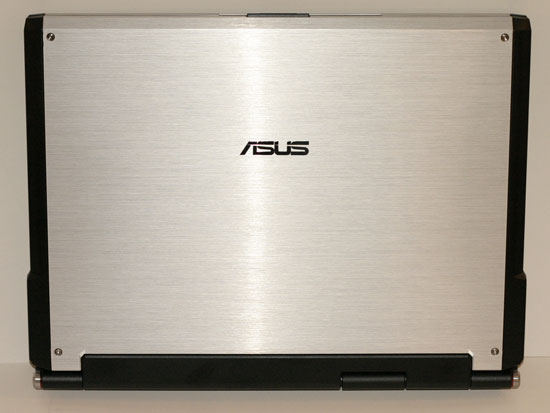 |
| Click to enlarge |
We're getting ahead of ourselves though, so let's talk a little bit about the laptop itself. Current prices on the G2P are around $1900, which is a bit more than the A8JS. You do get a larger 160GB hard drive, however, as well as 2GB of RAM standard on all G2P models. The price isn't an excellent bargain, but it isn't that bad either. Similar configurations from other manufacturers end up costing roughly $1800-$2000 as well, although the ability to customize your component selections might make the alternatives more attractive overall. The HP dv9000t for example offers very similar features (when upgraded) for about the same price.
Upon booting up the laptop you are greeted with a red and white logo accompanied by a gong noise and a subtitle proclaiming "ASUS Gaming Series". (The BIOS does allow you the option to disable the startup noise.) The exterior also gives the impression that this might actually be a gaming centric notebook, with red highlights in various locations, a glowing logo beneath the trackpad, and an interesting crosshatched "carbon fiber" pattern in the plastic around the keyboard as well as on the surface of the trackpad. The top of the laptop appears to be made of aluminum with a hard plastic coating to help resist scratching. Strictly in terms of appearance, the ASUS G2P impresses, and there are other good aspects as well.
One of the highlights of the laptop is definitely the LCD, which is easily the brightest and most vibrant laptop LCD we have used to date. The response time figure of 8 ms might be mostly marketing, but there's no denying the fact that this display looks better than the other displays in this notebook roundup. Given that we didn't have any difficulties using the other displays for a large variety of tasks, it's not too surprising that the G2P LCD worked without problems for everything we threw at it. Still, there is definitely a noticeable difference in viewing angle, brightness, contrast, and overall quality that can easily be seen with the naked eye. We would like to see this type of display on more notebooks, with one caveat: for a 17" laptop, we would really prefer to see 1680x1050 resolution at a minimum. Perhaps the lower maximum resolution somehow helps with the other improved characteristics, or it may simply be that this is one of the first of a new series of laptop LCDs and we will begin seeing improvements with higher resolution displays in the near future. The brightness does come at the expense of battery life, unfortunately, but you can always turn down the brightness when going mobile. (Maximum brightness in battery mode is also slightly dimmer than in AC mode.)
 |
| Click to enlarge |
Moving on from the display, let's take a quick look at the various ports and expansion options offered. Starting with the front of the unit, there are no ports, and the only buttons visible from the exterior are the front latch button along with some multimedia buttons. Just underneath the latch are five buttons that can be used for controlling media playback. The five buttons going left to right provide access to power, previous track, next track, stop, and play/pause functions. The power button will start Windows, but it does not cause Windows to shut down. It also causes the laptop to boot with a slightly different logo screen and without the gong noise (for no apparent reason). These keys work with various media players as expected. LED indicators for power, battery, email, and WiFi are visible to the right of the five multimedia buttons.
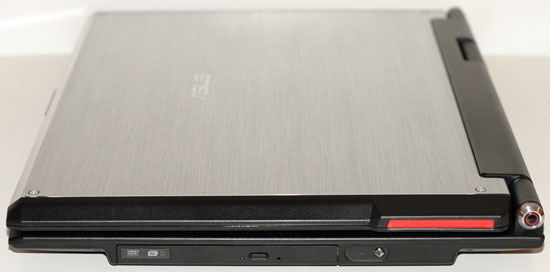 |
| Click to enlarge |
The right side of the A8JS is where the optical drive resides, and the only other item present on the right is the power adapter socket. There seems to be a lot of wasted space on the first two edges, and we certainly wouldn't have minded seeing at least a few USB ports on the right side.
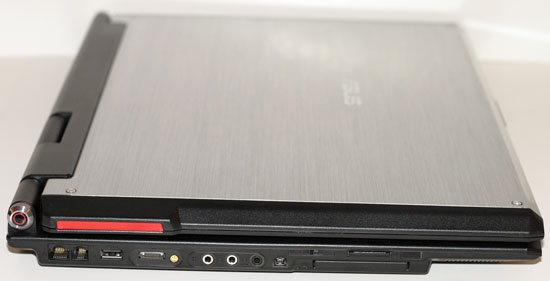 |
| Click to enlarge |
The left side of the laptop is where the vast majority of the connections are located. There's one USB port, an unpowered FireWire port, three audio jacks allowing for 5.1 analog speaker connections, and a headphone jack can also function as an optical S/PDIF output. Network and modem ports are available towards the rear of the laptop, while the front has a flash memory socket supporting MMC, SD, and MS/MS Pro. Below the flash slot is the ExpressCard 54 expansion slot. There's also a switch to turn the WiFi connection on or off and an infrared interface at the very front. Between the USB port and audio jacks are a couple of less common options for laptops. The thin port is for external SATA hard drives, while the round socket is the input for the integrated TV tuner.
 |
| Click to enlarge |
Finishing up with the rear of the unit and starting on the left, the first thing we see is the heat exhaust port. The intake ports are located on the bottom of the laptop, but this is the only exhaust. Given that this laptop is larger than the G2P and also features a less powerful graphics chip, the laptop doesn't get nearly as hot. Next to the exhaust is a security locking mechanism, followed by a TV output connector. The TV connector supports S-Video, component, and composite output. VGA and DVI ports are next, and once again the DVI port does not support dual-link DVI. Finally, at the far right are four USB ports.
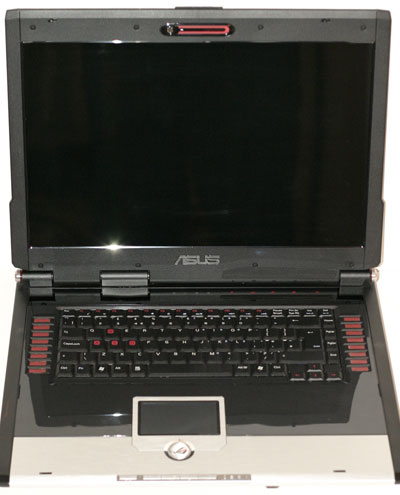 |
| Click to enlarge |
Opening up the unit, you can see the crosshatched pattern we were talking about earlier surrounding the keyboard. It looks pretty cool, but otherwise doesn't really serve any purpose. There's also a logo beneath the trackpad that is their purely for appearance, and it glows red when the system is turned on. (This same logo is displayed during the POST sequence.) To the top-left of the keyboard is a small LED display that normally lights up and reads ASUS; we don't know whether or not this display can be programmed to show other information. We've already talked about the display, which is really great, and just below the display are five more buttons: search, email, Internet, trackpad on/off, and the power button. Once again above the display is a webcam and microphone, only this time the webcam is a 1.3 megapixel model. During testing we found it provided a slightly better picture quality than the 0.3 megapixel model on the A8JS, although with four times as many pixels it certainly didn't appear four times as good. However, using Windows Movie Maker we were unable to capture video at a resolution higher than 720x576, which was likely a limitation of the software rather than the camera.
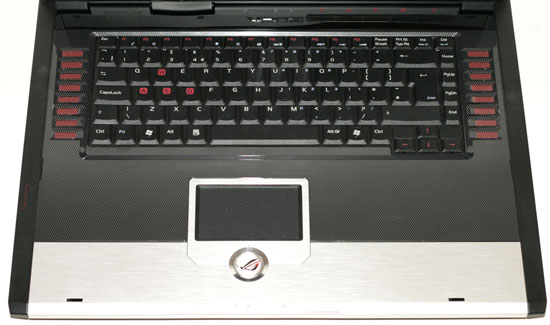 |
| Click to enlarge |
Taking a quick look at the keyboard, the layout is nearly identical to that of the keyboard on the A8JS. (We were apparently sent a European version, so the US version may be identical to the A8JS - which would be preferable, as the location of a few keys did cause confusion at times.) The problem is, with a much larger 17" chassis we really expect to see a number keypad on an optimally configured laptop. Rather than using a wider keyboard area, ASUS puts red decorative ventilation to the left and right of the keyboard. We say "decorative" as we couldn't tell that it was actually used for that purpose, and we're pretty sure it's not used for audio either as the speakers are located on the bottom front of the laptop. Such a layout does keep the keyboard centered relative to the display, but we still would have liked to see a number keypad instead. You can also see the red lettering on the WASD keys, once again helping to give the laptop the appearance of being suitable for gaming.










17 Comments
View All Comments
Ajax9000 - Sunday, January 7, 2007 - link
Some of us want a highly portable computer that can can drive a big screen at home or work. For us, a 13" or 14" laptop with (say) a Go7700+DL-DVI is actually way more useful than a 17" laptop with DL-DVI. Gaming isn't a priority for us and the 17" is too big for good portability and just gets in the way when used with a big screen on a desk.tinus - Thursday, January 4, 2007 - link
Why did you not include the Asus G1 laptop in the comparison, since you dislike the gpu on the G2 laptop? I would have loved to see a comparison between the A8js and the G1, since the only difference between the two ought to be the screen (both feature a Geforce Go 7700). Especially since you say that the screen on the G2 is so much better than that on the A8Js. If nothing else, I would much appreciate any comments regarding the G1 since i am looking a replacement for my current laptop, and the G1 seems to fit me perfectly.JarredWalton - Thursday, January 4, 2007 - link
Unfortunately, ASUS sent me the G2P - as I've frequently commented, we basically review what we get. I don't know why, as the G1 seems better overall. G1 is a 15.4" though, so the display may not be as good - without seeing it in person, I can't say, although I can put in a request to ASUS to get a G1 for review if you'd like. G1 also comes with either a 1280x800 (YUCK!) LCD or a 1680x1050 (HOORAY!) LCD - but if they're both more like the A8J LCD than the G2P then it's still sort of a wash as to which is best.tinus - Friday, January 5, 2007 - link
Thanks for the reply, but no, you do not have to request the G1, because I already found a review of it on another site, and they claim that it is the same screen as on the G2.And yes, the 1680x1050 screen would be perfect!
JarredWalton - Friday, January 5, 2007 - link
It can't be the same display, as the G1 is a 15.4" LCD and the G2 is a 17" LCD. Now, if it's the same quality overall, that would be good, and hopefully that's what you meant. :)tinus - Sunday, January 7, 2007 - link
Yea well.. you understand what I wanted to say ;)customcoms - Saturday, December 30, 2006 - link
on this page: http://anandtech.com/mobile/showdoc.aspx?i=2899&am...">http://anandtech.com/mobile/showdoc.aspx?i=2899&am...there is some mislabeling of the pictures (between the Asus G2P and the A8JS). It clear that this page is talking about the G2P but the article should still be fixed!
JarredWalton - Saturday, December 30, 2006 - link
This is the second image-related complaint, and again I'm a bit confused. Page 5 is definitely showing the G2P images, at least for me. I have no idea what you're seeing that convinces you otherwise, but please check it again and if you really aren't seeing the right images take a screenshot so I can figure out what you *are* seeing. Also, information on what browser and OS you're using could be helpful.yacoub - Saturday, December 30, 2006 - link
I found this review article very worthwhile. That Asus "gaming" laptop, however, is a joke with that GPU. =(Tommyguns - Monday, January 1, 2007 - link
I agree. Very happy seeing this review done. I've been looking at getting a laptop for awhile now and waited on the C2D's. Was gonna pick one up, but for the money vs performance, I was far too disapointed with the current GPU results. It seems there are reviews for all the desktop GPU's and graphed ect... but its impossible to get a clear understanding on the laptop side. X1600 was looking good. Perhaps a mass peformance testing of most of the current GPU's?Yeah, so basicly i am just really confused on how all these chips compare. Thanks for the review!